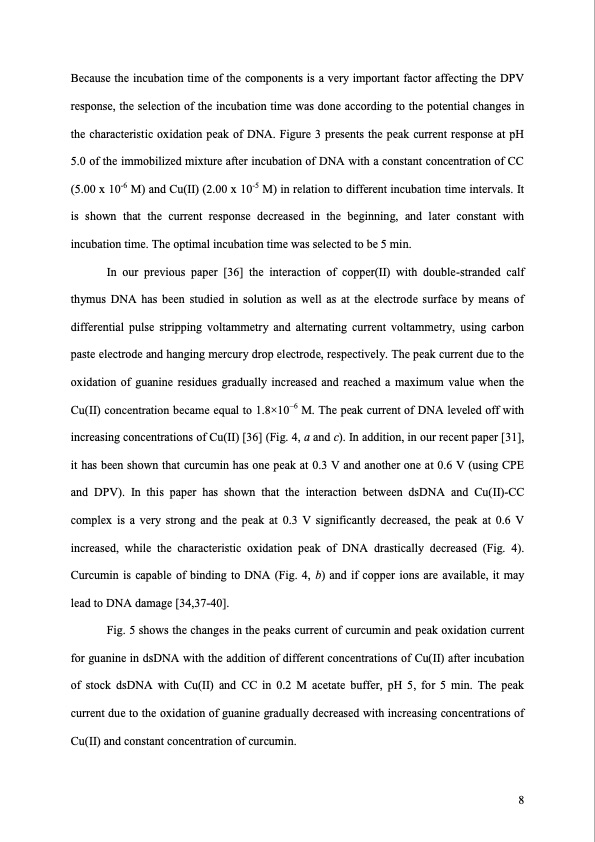
PDF Publication Title:
Text from PDF Page: 008
Because the incubation time of the components is a very important factor affecting the DPV response, the selection of the incubation time was done according to the potential changes in the characteristic oxidation peak of DNA. Figure 3 presents the peak current response at pH 5.0 of the immobilized mixture after incubation of DNA with a constant concentration of CC (5.00 x 10-6 M) and Cu(II) (2.00 x 10-5 M) in relation to different incubation time intervals. It is shown that the current response decreased in the beginning, and later constant with incubation time. The optimal incubation time was selected to be 5 min. In our previous paper [36] the interaction of copper(II) with double-stranded calf thymus DNA has been studied in solution as well as at the electrode surface by means of differential pulse stripping voltammetry and alternating current voltammetry, using carbon paste electrode and hanging mercury drop electrode, respectively. The peak current due to the oxidation of guanine residues gradually increased and reached a maximum value when the Cu(II) concentration became equal to 1.8×10–6 M. The peak current of DNA leveled off with increasing concentrations of Cu(II) [36] (Fig. 4, a and c). In addition, in our recent paper [31], it has been shown that curcumin has one peak at 0.3 V and another one at 0.6 V (using CPE and DPV). In this paper has shown that the interaction between dsDNA and Cu(II)-CC complex is a very strong and the peak at 0.3 V significantly decreased, the peak at 0.6 V increased, while the characteristic oxidation peak of DNA drastically decreased (Fig. 4). Curcumin is capable of binding to DNA (Fig. 4, b) and if copper ions are available, it may lead to DNA damage [34,37-40]. Fig. 5 shows the changes in the peaks current of curcumin and peak oxidation current for guanine in dsDNA with the addition of different concentrations of Cu(II) after incubation of stock dsDNA with Cu(II) and CC in 0.2 M acetate buffer, pH 5, for 5 min. The peak current due to the oxidation of guanine gradually decreased with increasing concentrations of Cu(II) and constant concentration of curcumin. 8PDF Image | Electroanalytical dsDNA and curcumin vs copper

PDF Search Title:
Electroanalytical dsDNA and curcumin vs copperOriginal File Name Searched:
ElectroanalyticalStudy.pdfDIY PDF Search: Google It | Yahoo | Bing
CO2 Organic Rankine Cycle Experimenter Platform The supercritical CO2 phase change system is both a heat pump and organic rankine cycle which can be used for those purposes and as a supercritical extractor for advanced subcritical and supercritical extraction technology. Uses include producing nanoparticles, precious metal CO2 extraction, lithium battery recycling, and other applications... More Info
Heat Pumps CO2 ORC Heat Pump System Platform More Info
| CONTACT TEL: 608-238-6001 Email: greg@infinityturbine.com | RSS | AMP |